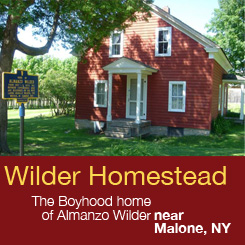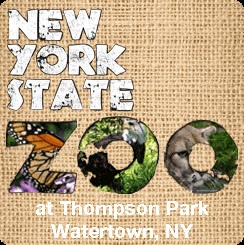
“Spectacular scenery unlike any
other in the Northeast.”
| Carthage Train Depot |
| Griffin Gorge and Waterfall |
| Black River Wild Forest |
| Blue Ridge Wilderness Area |

Explore by interest:
 VIEW AREA MAPS Maps of the region to view or print.
Area Maps
VIEW AREA MAPS Maps of the region to view or print.
Area Maps
 LOOKING for more information on Where to Stay and Where to Dine?
Plan Your Stay
LOOKING for more information on Where to Stay and Where to Dine?
Plan Your Stay
 CARING for our favorite natural and recreational resources - See the new guide
Invasive Species Alert
CARING for our favorite natural and recreational resources - See the new guide
Invasive Species Alert
All along the Scenic Byways are farmers markets, roadside vegetable stands, pick-your-own, and other opportunities to sample local foods
About the Adirondack Park
The Adirondack Park is different that any other designated park land in the U.S. and possibly in the world. How it differs from what one might expect in state or federal parks is sometimes surprising to first-time visitors. For example:
- There is no fee to enter the Adirondack Park and there are no gates at the entrances to the Adirondack Park. The boundary of the park is outlined on a map but the only demarcation on the ground are wooden roadside signs at various locations.
- Not all land within the Adirondack Park is public land. The Adirondack Park is a patchwork of public and private land, so signs that announce “No Trespassing” or “Private” should always be obeyed. Most communities have an information center or sporting goods store where maps and information are available that clearly identify the region's abundant public access opportunities.
- There are no large visitor centers at the entrances to the Adirondack Park. There are two State-operated Visitor Interpretive Centers (VICs) – one in Newcomb and one in Paul Smiths – where information about the Adirondack Park is provided, along with trail systems, interpretive displays, guidebooks, and friendly information. The VICs changed operators in 2011 - some details are available here:
- There are not Park Rangers wearing standard park uniforms as you might commonly see in a National Park, but there are forest rangers and conservation officers patrolling the hiking trails, campgrounds, rivers, lakes and roads of the Adirondack Park. They are employees of the New York State Department of Environment Conservation. Their headquarters at regional offices in Ray Brook, Warrensburg, Watertown, and Utica provide information about hiking, camping, fishing and other outdoor pursuits. NYS DEC officers and rangers also are posted in various communities throughout the region to enforce the laws, protect the environment, and provide information and assistance as needed.
Following is a short history of the Adirondack Park that describes how this “Great Experiment” came about and how it has evolved over the past century.
New York State has one of the oldest land preservation programs in the United States. In 1885, based in part on the writings of NY State surveyor Verplanck Colvin, the State Legislature established the Forest Preserve. The act declared a large amount of Adirondack forestland as “Forever Wild.” Shortly afterward, in 1892, a legislative bill established the Adirondack Park and indicated its boundary with a “Blue Line” that encompassed both public and private land. That was followed in 1894 by a Constitutional Convention and popular vote that added protection of the Forest Preserve to the State Constitution. The state of New York now owns approximately 2.6 million acres, or 43 percent of the land within the Park’s boundary.
A study commission appointed by Governor Rockefeller recommended the creation of the Adirondack Park Agency – the APA – in 1971 to develop a long-range land use plan for both the public and the private lands within the Blue Line. In consultation with the Department of Environmental Conservation, the Park Agency formulated the State Land Master Plan to accommodate outdoor recreation uses of the Forest Preserve without diluting the intent of its "Forever Wild" protection. The State Land Master Plan classifies all of the public lands in the Park into five major categories: Wilderness, Primitive, Canoe, Wild Forest, and Intensive Use.
The Adirondack Park Land Use and Development Plan applies to the remaining 3.4 million acres of private land in the Park. That Plan is designed to conserve the Park’s natural resources and open-space character by directing and clustering private development so as to minimize its impact. Under the Plan, all private lands are mapped into six land use classifications: hamlet, moderate intensity use, low intensity use, rural use, resource management, and industrial use. Guidelines are specified for the intensity of development within each category based on number of buildings per square mile. Significant development projects usually require a permit from the APA.
About 135,000 people live within some of that private land area, in 105 towns, villages, and other settlements. There are still large areas of private land that are devoted to forestry and agriculture, while other areas are totally undeveloped or used for recreation of some type. As a result, the Adirondack Park is a unique mixture of communities and private land holdings interspersed among the large tracts of public land that are available for all to enjoy. That blending of private and public lands gives the Adirondacks an unusual diversity of communities, forest areas, commercial centers, mountain landscapes, and vacation resorts. Within that diversity are a variety of ecosystems supporting significant populations of fish, wildlife, birds, rare plants, and other flora and fauna.
Designated wilderness areas make a significant contribution to those valuable ecosystems. In contrast with the majority of land in the eastern U.S. where human activity and development dominate the landscape, the Adirondack Park wilderness areas have no permanent evidence of human activity. Humans can visit or travel through a wilderness area under their own power, but their presence is fleeting or ephemeral.
A wilderness area is an area of state land or water having a primeval character which is protected and managed so as to preserve, enhance – and restore if necessary – its natural conditions, and which:
- Generally appears to have been affected primarily by the forces of nature, with the imprint of man's work substantially unnoticeable;
- Has outstanding opportunities for solitude or a primitive and unconfined type of recreation;
- Has at least ten thousand acres of contiguous land and water or is of sufficient size and character as to make practicable its preservation and use in an unimpaired condition; and
- May also contain ecological, geological or other features of scientific, educational, scenic or historical value.
New York State has more state-designated wilderness land than any other of the 49 states. When total acres of both federal and state wilderness are combined, New York ranks 13th among all states in terms of total acres designated as wilderness. Florida is the only other state east of the Mississippi River that is in the top 13. There are now 18 designated wilderness areas within the Adirondack Park – over one million acres in all – where powered vehicles of any type are not allowed. The size of each wilderness area in the Adirondack Park is summarized as follows:
- Blue Ridge Wilderness Area - 45,736 acres (185.09 km2)
- Dix Mountain Wilderness Area - 45,208 acres (182.95 km2)
- Five Ponds Wilderness Area - 117,978 acres (447.44 km2)
- Giant Mountain Wilderness Area - 22,768 acres (92.14 km2)
- Ha-De-Ron-Dah Wilderness Area - 26,528 acres (107.36 km2)
- High Peaks Wilderness Area - 192,685 acres (779.77 km2)
- Hoffman Notch Wilderness Area - 36,231 acres (146.62 km2)
- Jay Mountain Wilderness Area - 7,100 acres (28.7 km2)
- McKenzie Mountain Wilderness Area - 37,616 acres (152.23 km2)
- Pepperbox Wilderness Area - 22,560 acres (91.30 km2)
- Pharaoh Lake Wilderness Area - 45,883 acres (185.68 km2)
- Pigeon Lake Wilderness Area - 50,100 acres (202.8 km2)
- Round Lake Wilderness Area - 11,000 acres (44.5 km2)
- Sentinel Range Wilderness Area - 23,252 acres (94.10 km2)
- Siamese Ponds Wilderness Area - 112,524 acres (455.37 km2)
- Silver Lake Wilderness Area - 105,270 acres (426.01 km2)
- West Canada Lake Wilderness Area - 156,695 acres (634.12 km2)
- William C. Whitney Wilderness Area - 20,500 acres (83.0 km2)
There is also the 19,000-acre (77 km²) Saint Regis Canoe Area, presently the only Canoe Area in the Park and is managed essentially as a Wilderness Area.
As you travel along the Scenic Byways in the Adirondack Park you will at times be traveling beside a wilderness area and in a few areas there is wilderness land on both sides of the road. In those locations the Scenic Byways serve as wilderness corridors, making a visit to those rare landscapes accessible to all who take the time to make the journey.
For more information about the Adirondack Park:


